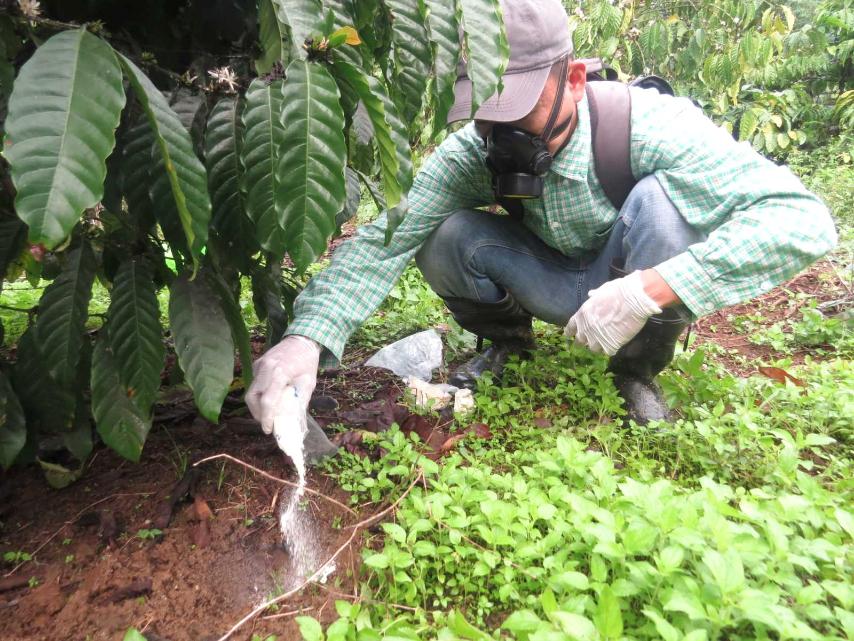FertiGroe® N, P, and K nanofertilizer, which was tested on rice, corn, eggplant, cabbage, potato, sugarcane, coffee, cacao, and banana showed that it helped reduce the amount of inorganic fertilizer application by 50%; increased net profit; and obtained comparable yields with those applied with conventional fertilizers
By Alithea De Jesus
Photos courtesy of DOST-PCAARRD Applied Communication Division
There is waste in haste, the old adage goes. And for the old folks, wasting food or sources of food is akin to throwing away the blessings.
As early as last year when the pandemic kicked off across the world, studies revealed by many economic experts that agriculture will play a key role in stabilizing the economy. But there are various ways how agriculture is being rolled out. For others, they go the “easy way” which in the process, turns out to be disastrous, while others opt to embrace the sustainable way and the best practice in agriculture..
The Philippines introduced ‘nanotechnology’, and studies revealed that it plays a significant role in agriculture and agricultural product development. One innovative nanotechnology is the nanofertilizers, which offer a greener approach to nutrient management through increased nutrient use efficiency (NUE) and reduced nutrient leaching into groundwater.

Use of nanofertilizers is an emerging approach to achieve a more sustainable and eco-friendly agricultural production. Nanofertilizers address environmental hazards posed by the increased and unregulated use of synthetic fertilizers. Excessive use of synthetic fertilizers causes high soil toxicity and soil imbalance. With high NUE, nanofertilizers reduce fertilizer application frequency, thereby minimizing the adverse effects of using too much synthetic fertilizers.
Given the advantages of nanofertilizers, the Agricultural Systems Institute and Institute of Crop Science of the University of the Philippines Los Baños (UPLB) developed FertiGroe® nitrogen (N), phosphorus (P) and potassium (K) nanofertilizers. The process of production and use of these nanofertilizers were optimized through the program, “Optimization of the Production and Use of FertiGroe® N, P, and K Nanofertilizers in Selected Agriculture Crops.” The said program is funded by the Department of Science and Technology (DOST) and monitored by the DOST-Philippine Council for Agriculture, Aquatic and Natural Resources Research and Development (DOST-PCAARRD).
FertiGroe® N, P, and K nanofertilizers are inorganic single fertilizers in powder or granulated form. They contain 29% N, 13% (phosphoric acid or phosphorus pentoxide (P2O5), and 48% potash or potassium oxide (K2O), respectively. They are called slow-release fertilizers, meaning the nutrients are gradually released into the soil, making nutrient delivery to crops more effective, nutrient use and plant absorption more efficient, and nutrient loss lesser.

The nanofertilizers were tested on rice, corn, eggplant, cabbage, potato, sugarcane, coffee, cacao, and banana in Batangas, Benguet, Bukidnon, Davao City, Davao del Norte, Davao del Sur, Isabela, Laguna, Misamis Oriental, Negros Occidental, and Nueva Ecija. Generally, test results showed that these nanofertilizers helped reduce inorganic fertilizer use by 50%; higher net profit; and yields comparable with those from using conventional fertilizers.
According to UPLB researchers, in annual crops such as rice, corn and potato, use of FertiGroe® N, P, and K nanofertilizers reduced fertilizer application by as much as 50% compared with using conventional fertilizers. With increased yield and lower application rates, the net profit also increased by 40% in rice, 20% in corn, and 48% in potato.
Moreover, when applied at the recommended rates similar to conventional fertilizers, FertiGroe® nanofertilizers increased yields of eggplant by 36% and of cabbage by 5%, translated into a 58% and 6% increase in net income, respectively.
In perennial crops, like sugarcane, FertiGroe® nanofertilizers increased cane tonnage by 46% and sugar yield by 40%. It also reduced the application rate by 45% of the recommended rate while improving the stalk length, weight and diameter of the millable cane yields.
With FertiGroe® nanofertilizers, the amount of fertilizers applied was reduced by 33.5% in coffee resulting in 104% increase in coffee berry yield. In cacao, the recommended rate was reduced by 50%, while giving 106% increase in cacao pod yield. Moreover, labor costs were reduced and yields increased, which provided an additional income to coffee and cacao growers. With considerable reduction in fertilizer inputs, a positive net profit of about P 20,000 after one year of application was realized in both coffee and cacao.
In banana, FertiGroe® nanofertilizers increased the number of hands per bunch in “saba” and reduced the amount of rejects in cavendish, thereby increasing the marketable yield in “saba” by 22% and cavendish by 24%.
The outputs of the program and benefits of nanofertilizers were discussed during the research program webinar held on April 15, 2021, participated in by 320 attendees via Zoom, Facebook, and YouTube. It was spearheaded by UPLB program leader, Dr. Pearl B. Sanchez, together with the project leaders, Dr. Lilia M. Fernando, Dr. Jose E. Hernandez, Mr. Gerardo B. Gauna, Dr. Pompe C. Sta. Cruz, Prof. Babylyn T. Salazar, and Dr. Edna A. Aguilar. It served as a means to share the program’s innovative strategy of incorporating nanotechnology in agriculture to obtain sustainable crop yields, effectively reduce fertilizer inputs, and significantly increase net profits.
UPLB implemented this program in partnership with All Trade Marketing and Manufacturing (ATMM), Philippine Rice Research Institute (PhilRice), Isabela State University (ISU), Central Mindanao University (CMU), Cagayan Valley Research Center (CVRC), Nagcarlan Municipal Office of Agriculture, Benguet State University (BSU), La Granja Research and Training Station (LGRTS-UPLB), University of Southeastern Philippines (USeP) -Tagum and Mabini Campuses, University of Science and Technology in Southern Philippines (USTsP)-Claveria, Southern Philippines Agribusiness and Marine and Aquatic School of Technology (SPAMAST), and Lapanday Foods Corporation.














